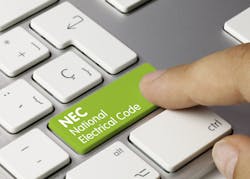Proposed Structure Changes for the 2029 NEC
In March of 2022, the National Electrical Code (NEC) Correlating Committee formed a “Structure” Task Group to begin reviewing the current NEC structure to determine if changes are warranted. This wasn’t the first time a group had been formed to address this issue. In the ’90s, the Correlating Committee debated the NEC structure when challenges with medium-voltage (MV) installation requirements arose; however, it was determined that the existing structure was adequate, and the MV requirements were dispersed throughout the Code.
Here is a little trivia for the next shop safety meeting: Does anybody know when the current structure (nine chapters) that we have in the 2023 NEC was introduced? It was in the 1937 NEC. Interestingly enough, when we make a few comparisons from that time in history to today, although the same structure remains, we find that the 1940 edition looked much different than today’s NEC.
As new technologies, products, and their applications emerge, the NEC technical committees are faced with a dilemma — where should this widget be placed in the Code? Also, regarding the challenges of the current structure, members of today’s Task Group started asking questions like:
- What is the difference between a general requirement and a special requirement?
- Are electrified truck parking spaces a piece of electrical equipment?
- Is a natural and artificial body of water a piece of electrical equipment?
- Is a fire-resistive cable system a condition?
The electrical industry has changed a lot since 1937. Today, the digital revolution has changed how we get our information. Gen Z will be the first generation to grow up with access to the internet, digital technology, and social media platforms. In addition, we see product standards continue to be harmonized across the world. Now, DC is emerging as the new AC, and since the mid-2000s, renewable technologies have been shifting the paradigm of electric utilities.
When considering these structure changes, the Task Group must ask itself: Where do we want to end up, and what’s the end game? The Task Group not only wants to see the NEC continue to be relevant in the quickly evolving electrical industry, but it also wants to leverage the past and make the future even better. The end game is to make the NEC more user-friendly by eliminating redundancy, placing content where it makes sense, utilizing a logical/parallel structure, and improving the limited energy and MV content.
Thankfully, these proposed changes will not happen in one Code cycle. Once it has been determined that the Correlating Committee will move forward based on feedback from the industry, the Task Group would like to continue making changes in the 2026 NEC cycle to simplify the 2029 NEC transition.
The Figures show a small sample of where the Task Group is today (Fig. 1), how this might evolve in the 2026 NEC (Fig. 2), and finally, where they want to be in the 2029 NEC (Fig. 3). Parallel numbering and grouping are important for the usability of the NEC, so when considering the changes to the 2026 NEC, one thought is to combine Chapter 7 and Chapter 8 requirements by grouping similar wiring methods and installation practices. Also, with the new Articles in place for the MV requirements which happened in the 2023 NEC, those requirements could be numbered and grouped to align more closely with the Chapter 2 wiring and protection requirements.
The Task Group has also considered additional chapters to better group similar equipment, sources, and occupancies. As an example, in the Table on page 18, life safety and emergency systems could be grouped in one location.
In April 2023, the NFPA released the Correlating Committee white paper titled “Keeping the NEC Relevant — Is Now the Time to Modernize?” to describe the need for a revised structure and to socialize the concept. The Task Group continues to meet regularly, review the feedback and comments, and make changes. Since the last meeting, the Task Group has received favorable letters of support from industry stakeholders including the IAEI, UL, IEC, Minnesota Department of Labor as well as other individuals.
To summarize, at the bottom of the Correlating Committee white paper, there is an opportunity for comments or feedback. Here’s a quote from that document.
“Ensuring the NEC is reflective of the industry that uses it daily should be of interest to all who use the document. To that point, we would like your feedback on the draft modernization outline. Please provide your feedback to the NEC staff liaison, Jeff Sargent@[email protected].”
Please consider sharing your comments and/or suggestions.
Dean Hunter is the chief electrical inspector for the Minnesota Department of Labor and Industry.
About the Author
Dean Hunter
Dean Hunter is the chief electrical inspector for the Minnesota Department of Labor and Industry. He currently serves as an IAEI representative on the NEC CMP-7 (formally CMP-19) and is a member of the UL Electrical Council. He also participates as a technical committee member on NFPA 225, 501 and 501A.




